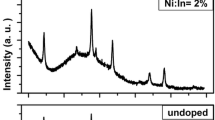Abstract
The effect of antimony doping of tin dioxide at Sb/Sn = 0.2–2.5 on the physical properties and structure of air-dry samples of hydrous tin dioxide, SnO2 ∙ nH2O (HTD), was studied by IR and Raman spectroscopy, powder X-ray diffraction, impedance measurements, TGA, and electron microscopy. The doped materials retained the structure of undoped HTD materials if the Sb/Sn ratio did not exceed the threshold value of 1.0. When Sb/Sn > 1, crystalline antimony oxide admixture appeared. The data of IR spectroscopy attested to the presence of two types of water in HTD-Sb, namely, physisorbed and chemisorbed water. The major part of water of the former type can be removed by evacuation at room temperature. Chemisorption occurs upon coordination of water molecules by metal ions through the formation of metal–oxygen bonds. Water molecules of the latter type are retained in evacuated samples at room temperature and on heating above the boiling point of liquid water. By impedance spectroscopy, HTD-Sb samples were shown to possess fairly high proton conductivity at high humidity; however, the conductivity decreased by two orders of magnitude after partial removal of water molecules of the former type. This attests to the destruction of the loosely bound hydrogen bond network, across which proton transfer takes place. It was also found that under conditions of constant humidity, the proton conductivity successively decreases with increasing antimony concentration. This is attributable to the fact that Sb(III) ions polarize the local environment to a lesser extent than Sn(IV) ions.
Similar content being viewed by others
References
V. V. Ivanov, I. A. Sidorak, A. A. Shubin, and L. T. Denisova, J. Siberian Fed. Univ. Eng. Technol. 2, 189 (2010).
D. Vayfrey, M. Ben Khilifa, M. P. Besland, et al., Proc. SPIE—Int. Soc. Opt. Eng. 4464, 103 (2002).
J. Rockenberger, U. Felde, M. Tisher, et al., J. Chem. Phys. 112, 4296 (2000).
R. Koivula, R. Harjula, and J. Lehto, Micropor. Mesopor. Mater. 55, 231 (2002).
V. Müller, M. Rasp, G. Stefanic, et al., Chem. Mater. 21, 5229 (2009).
Yu. Dobrovolsky, L. Leonova, and A. Vakulenko, Solid State Ionics 86–88, 1017 (1996).
D. R. Pyke, R. Reid, and R. J. D. Tilley, J. Solid State Chem. 25, 231 (1978).
D. R. Pyke, R. Reid, and R. J. D. Tilley, J. Chem. Soc., Faraday Trans. 1, 1174 (1980).
J. L. Portefaix, P. Bussiere, M. Forissier, et al., J. Chem. Soc., Faraday Trans. 1, 1652 (1980).
Yu. E. Roginskaya, D. A. Dulin, S. S. Stroeva, et al., Kinet. Katal. 9, 1143 (1968).
T. N. Fetisova, V. R. Mirolyubov, and S. F. Katyshev, Russ. J. Gen. Chem. 77, 1643 (2007).
F. J. Berry and C. Greavez, J. Chem. Soc., Dalton Trans., 2447 (1981).
F. J. Berry and B. J. Laundy, J. Chem. Soc., Dalton Trans., 1442 (1981).
Yu. Dobrovolsky, L. Leonova, S. Nadkhina, and N. Panina, Solid State Ionics 119, 275 (1999).
Handbuch der präparativen anorganischen Chemie, Ed. by G. Brauer, (Ferdinand Enke, Stuttgart, 1975–1981; Mir, Moscow, 1887).
A. V. Kostrikin, F. M. Spiridonov, I. V. Lin’ko, et al., Russ. J. Inorg. Chem. 52, 1098 (2007).
L. M. Sharygin, S. M. Vovk, V. F. Gonchar, et al., Russ. J. Inorg. Chem 28, 576 (1983).
A. I. Karelin, L. S. Leonova, A. V. Arsatov, and Yu. A. Dobrovol’skii, Russ. J. Inorg. Chem 58, 563 (2013).
A. I. Karelin, L. S. Leonova, A. V. Arsatov, and Yu. A. Dobrovol’skii, Russ. J. Inorg. Chem. 58, 711 (2013).
L. M. Sharygin, T. A. Denisova, S. M. Vovk, et al., Russ. J. Inorg. Chem 30, 1968 (1985).
E. W. Thornton and P. G. Harrison, J. Chem. Soc., Faraday Trans. 71, 461 (1975).
L. H. Little, Infrared Spectra of Adsorbed Molecules (Academic, London, 1966; Mir, Moscow, 1969).
Author information
Authors and Affiliations
Corresponding author
Additional information
Original Russian Text © A.I. Karelin, N.S. Tkacheva, S.E. Nadkhina, L.S. Leonova, A.M. Kolesnikova, L.S. Usacheva, A.V. Levchenko, Yu.A. Dobrovol’skii, 2016, published in Zhurnal Neorganicheskoi Khimii, 2016, Vol. 61, No. 9, pp. 1201–1210.
Rights and permissions
About this article
Cite this article
Karelin, A.I., Tkacheva, N.S., Nadkhina, S.E. et al. Structure of hydrated tin dioxide doped with Sb(III) ions. Russ. J. Inorg. Chem. 61, 1144–1152 (2016). https://doi.org/10.1134/S0036023616090084
Received:
Published:
Issue Date:
DOI: https://doi.org/10.1134/S0036023616090084



